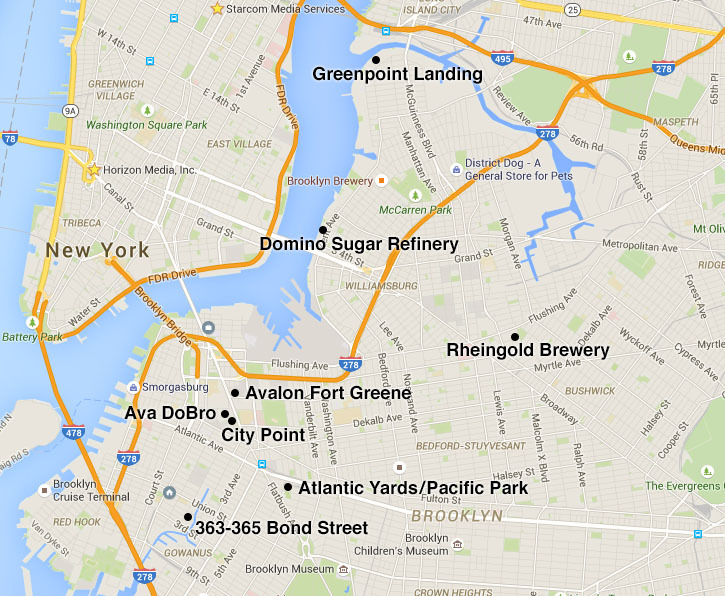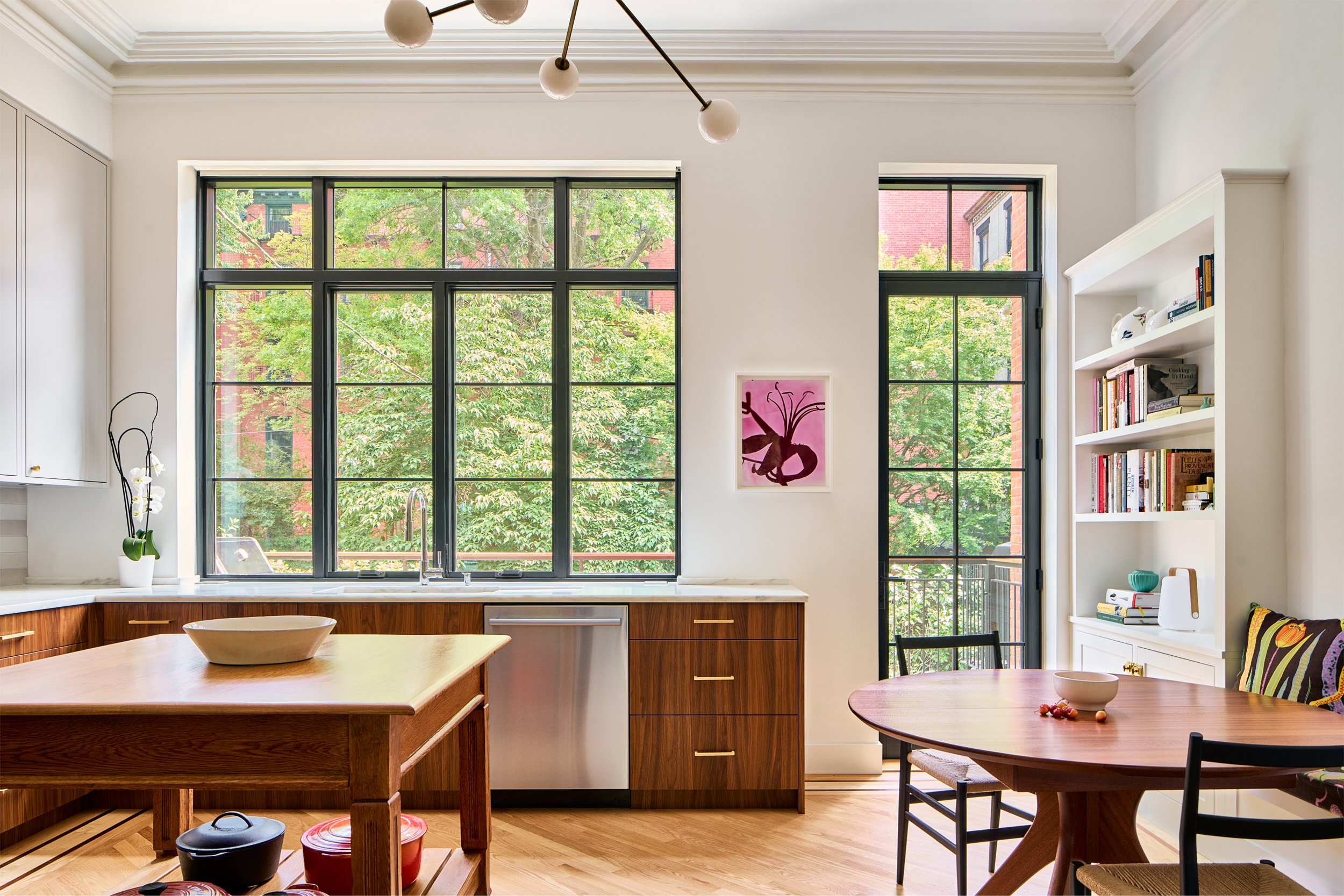Seven Residential Mega-Projects Changing the Face of Brooklyn
Brooklyn has been home to a massive wave of development over the last decade that has transformed the borough. Some of the biggest changes occurred in Dumbo, Downtown, along 4th Avenue, and in Williamsburg, where luxury high rises have replaced industrial and commercial uses. More transformation is coming, thanks to some mega-size residential projects that…
Brooklyn has been home to a massive wave of development over the last decade that has transformed the borough. Some of the biggest changes occurred in Dumbo, Downtown, along 4th Avenue, and in Williamsburg, where luxury high rises have replaced industrial and commercial uses.
More transformation is coming, thanks to some mega-size residential projects that are in the pipeline for the coming decade (and many within the next few years). Some are the size of small towns.
We rounded up some of the largest ones, projects with close to 700 units or more. Some have been immensely controversial (think Atlantic Yards, now Pacific Park). Most have encountered significant opposition — Lightstone, Greenpoint Landing, City Point.
Early opposition to the vast Rheingold Brewery development seems to have been headed off, at least for now, by changes made during the public review process that resulted in a successful rezoning. Domino stands out as a project that, because of its unique design, community facilities and affordable housing, has received an unusually warm welcome and even excitement.
A handful more mega-projects are on the drawing board, but were not included because they haven’t reached the permitting stage.
Atlantic Yards/Pacific Park
The controversial project (a rendering of a portion of which is pictured above) — the subject of protests, lawsuits and a feature-length documentary — was proposed over a decade ago. And now it is now well under way.
A lot has changed. The original designer of the project, celebrated starchitect Frank Ghery, is long gone. The developer, Forest City Ratner, has taken on a Chinese financial partner, Greenland Holdings, and the name has changed from Atlantic Yards to Pacific Park.
The arena boosted Brooklyn’s profile when it opened in 2012, and construction has finally started on some of the residential towers. Earlier this month, permits were filed for the latest apartment building at 615 Dean Street, a 26 story high-rise with 244 market-rate condos. In May, the last homeowner was evicted from the site via eminent domain.
When complete the project will be vast. It will stretch from 4th Avenue to Vanderbilt Avenue between Atlantic Avenue and Dean Street. Plans call for 15 buildings with 6,430 units of housing over 6 million square feet — 2,250 units will be affordable.
The project will have 247,000 square feet of retail space and at least 336,000 square feet of commercial space (and possibly much more). The developer has said it expects the entire project to be complete by 2025.
Atlantic Yards/Pacific Park Coverage [Brownstoner]
Rendering by SHoP Architects
Greenpoint Landing

The northwest corner of Greenpoint will be utterly transformed when Greenpoint Landing is complete. The area had been home to mostly low-rise industrial buildings.
The developer, Park Tower Group, plans to construct 10 towers that will rise 30 to 40 stories on the site for a total of 5,500 apartments. The design here has changed as well — renderings originally showed glass and steel towers, and now the towers and shorter buildings are shown in more contextual brick.
The 22-acre site will also be home to a park, and the developer plans to build a new, 640-student elementary school. Over 1,400 of the units will be affordable housing.
Greenpoint Landing Coverage [Brownstoner]
Rendering by Handel Architects
Domino Sugar Refinery
Developer Two Trees, which is credited with the reinvention of Dumbo, is developing the site around the former Domino Sugar Refinery in south Williamsburg. When complete, the project will have four high rises with 2,300 apartments (700 of them will be affordable units) grouped around the landmarked 1880s refinery building. Two Trees is also including 631,000 square feet of office space and four acres of open space primarily along the East River waterfront.
Domino Sugar Refinery Coverage [Brownstoner]
Rendering by SHoP Architects
AvalonBay’s Downtown Brooklyn Towers
Developer AvalonBay will eventually have two massive rental towers in Downtown Brooklyn. Its first there, Avalon Fort Greene at 343 Gold Street, opened its 631 units to renters in 2009.
Another, Ava DoBro, at 100 Willoughby Street, just listed its first rental units last month. A third development, Avalon Willoughby Square at 214 Duffield Street, will occupy the upper floors of the same building.
When complete, it will be Brooklyn tallest building at 575 feet and will have 861 units.
100 Willoughby Street Coverage [Brownstoner]
Photo by Cate Corcoran
Rheingold Brewery
The rezoned Rheingold Brewery site is a sprawling 6.4-acre parcel of land in Bushwick roughly bordered by Bushwick Avenue, Evergreen Avenue, Melrose Street and Flushing Avenue. The former factory site is slated to eventually become a vast mixed-use development with 10 buildings and 977 apartments, 30 percent of which will be affordable.
Read Property Group, the primary developer of the Rheingold site, has filed for permits for one of the buildings, at 123 Melrose Street. It will be 80 feet tall and have 385 units. Twenty percent of the units will be affordable.
Simon Dushinksy’s Rabsky Group filed plans for another building on the site at 10 Montieth Street — a seven story, 393-unit rental building with a 25,000 square foot green roof. It’s one of the most unusual looking buildings planned in Brooklyn, with a design by ODA reminiscent of ancient cliff dwellings.
Rheingold Brewery Coverage [Brownstoner]
Image by Read Property Group
363-365 Bond Street
The two rental buildings that are being developed by Lightstone Group at 363-365 Bond Street in Gowanus will be a mere 12 stories tall — a world of difference from downtown high-rises. But the complex will also be large, with 697 units total across 564,000 square feet (and 140 affordable units).
The buildings will have parking and bike storage as well as an outdoor pool and a library. Construction on the first and larger building is well under way. Windows were going in and the brick facade was rising when we visited last month. The first building is expected to be completed by 2016.
363-365 Bond Street Coverage [Brownstoner]
Rendering by Lightstone
City Point
The massive retail and residential project at 1 Dekalb Avenue, also in Downtown Brooklyn, is mid-construction. The first phase is a 50,000 square foot retail space, still under construction and re-opening soon.
Phase two, under construction now, includes a 650,000 square foot mall and will be home to Century 21 and other retailers. The residential portion will have 690 apartments, and 125 of them will be affordable.
Phase three is still in the planning stages but will be a large residential tower, with perhaps 500 rental apartments. When complete by 2020, City Point will have residential, retail and office space totaling about 1.8 million square feet.
Brownstoner City Point Coverage [Brownstoner]
Rendering by CookFox












No one moved/moves to Downtown Brooklyn for the trees, low-slung houses, and street life. LOL. Downtown Brooklyn is one of the best places in all of New York City to encourage this type of development, precisely because it DOES have the infrastructure in place. *EXCEPT* schools, and they need to figure that out, because there’s going to be a crisis in a couple years. Otherwise, I can’t say anything bad about high-rise development in Downtown Brooklyn, except that there needs to be some new office construction as well. The market isn’t there for it right now (rents support healthy leasing, but don’t yet support new Class A construction).
.
Atlantic Yards/Pacific Park, well, also one of the better places for that kind of density. I just wish it didn’t need to be so ugly.
As tragic as the aesthetics of this is to those of us who came to Brooklyn for the tree-lined streets and open blue skies feel, the part that’s most distressing is the lack of any discussion around increasing city services and infrastructure for all these additional units of housing. LICH closed so the hospitals in the area are over-taxed, the schools are bursting and already provide near third-world quality education with student/teacher ratios no civilized nation should tolerate. And finally the Atlantic Avenue Terminal – JUST renovated – is often so crowded in the platform that you need to wait for two or three trains before being able to board. I don’t understand where the urban planners are in all this, how can they assume that these neighborhoods can absorb these massive influxes of people without providing adequate services? Every developed should be required to contribute to the infrastructure needed to support these new residents. They should not profit at the expense of the community.
With the exception of City Point they’re all quite ugly. SHoP is really staining the NYC landscape. Downtown Brooklyn is still underdeveloped.
There’s also LICH. That will be something like 500-1000 units.
These buildings won’t drive rental prices down, but they might slow the rising rate of prices.
Brooklyn population still about 100,00 shy of its historical high of 270,000, from 1950. Although I suppose there were more people living in each apartment back then.
If more and more people are working in Downtown Brooklyn, or not commuting to Manhattan on a daily basis, and folks can put up with a commute of 45 min-1hr, there’s still plenty of room left.
Not a fan of the supertowers in low-rise neighborhoods. Wish they could keep the in downtown Brooklyn, Midtown, and the Financial District. You can look to a residential neighborhood like Tribeca where most of the streets/buildings don’t get any true sun/daylight due to Independence Towers and Citibank.
On a separate note, and this is not a for or against, but a topic of curiosity – will the towers equally offset the recent change in housing density in the townhouse market? aka the trend towards single family, or larger duplex units for larger households/famlies.
These buildings are nightmares. It might be great for the random person who wins an affordable apartment and the developers will get rich (why else would they undertake?) but for the lowlying neighborhoods surrounding these monstrosities, it won’t be pleasant. Nobody wants to live with a massive tower looming over you. Even if I could have afforded one of those high rises in Manhattan twenty years ago, I wouldn’t have. I chose Brooklyn for the life of the streets. And the trees. And the sense of history in the architecture.
Go read Jane Jacobs. Take a stroll under those monoliths. Like what you see? Want more Chipotles? More Starbucks? High rises kill street life.
Bill Deblasio might think he’s a savior by handing out tax breaks to the developers who are throwing these buildings up and I guess New York will survive but a mayor who slashes library spending while helping developers build glass boxes? He will go down as one of the worst mayors in New York. Ever.
“I doubt you have read Jane Jacobs?”
Pg. 50, “Under the seeming disorder of the old city…it essence is intricacy of sidewalk use, bringing with it a constant succession of eyes.”
Why are the dumbest people always the meanest?
Vacancy is an imperfect metric, and there are indeed other forces affecting demand. Of course these towers could be expected to affect housing costs -specifically in a particular market segment. That doesn’t really address the other points about the impacts
Driving rent down by increasing vacancy is total hogwash in the first place, an idea used by developers and their friends at City Hall to move profitable projects into the pipeline. Does anyone think building luxury housing in working-class neighborhoods (with a percentage of lower-cost units set aside, affordable only in the context of the entire borough and often not contextual with local wages) is going to solve the rent crisis instead of the opposite?